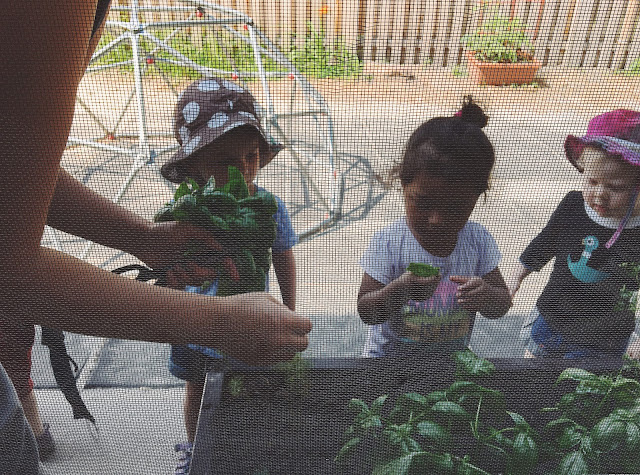 |
| curly kale |
We serve a lot of vegetables at BCS. And we are often asked how we persuade the kids to eat them. When we talk to folks from other schools like ours we hear many variations of "we WANT to serve more vegetables, but the kids just hate them" or "the kids will only eat baby carrots with ranch", or " I can't stand to throw away a salad after no one touches it".
The truth is, we don't have a quick answer to the question. What we do have are a few concepts we believe in when it comes to feeding, teaching, and caring for young kids.
One is shared responsibility, which I wrote a bit about here.
Basically we believe that kids should ultimately be responsible for what they eat - assuming they are choosing from options provided for them by adults who have their heath and well-being in mind. We believe that kids are competent learners, and that they should be trusted to try things out in their own time. We know that it can take several offerings of a new food before a child accepts it. We are also aware of the cultural impact of this model. Meaning, we know that a family's economic status changes their ability to repeatedly offer expensive fresh foods to their kids only to have them rejected. Wasting food, or spending money on food that might have to be thrown away is simply not an option for most low-income families. But low-income families shouldn't be forced out of healthy food choices.
At our school we strive to offer at least a temporary fix for that problem with our food program, during the precious, early years we spend with our kids and families. Of course we aim to waste as little food as possible - because we have to maintain the bottom line for our program. But we also encourage kids to put something new on their plate, even if we know they may not eat it the first time. Or the second, or the third. Just serving oneself some kale sesame salad is an important step toward food literacy, and we applaud it, even if it takes a few attempts to bite into that kale.
We also believe that the emotional tone of the kitchen, and the mealtime, contributes to the ability of kids to regulate their bodies and eat well. In other words, even in the kitchen, or maybe especially in the kitchen, relationships are front and center. How do we gather together? How do we interact at meal times? How do we all support each other to get what we need to get through our day?
Well, we wash our hands, we take some deep breaths, we find a seat and serve ourselves. We pass to others. We remind each other to take what we need, and give new things a try. We remind kids that at school, we will always refill the bowl if it's empty, until everyone has had enough.
And we tell stories.
I'm a talker. It's how I relate, get to know others, and show others who I am. I'm always working on quieting down and listening, but it's a challenge for me. Often when I'm engaged in conversation with someone else instead of really listening closely I'm scanning for details, looking for common ground and thinking of what I'm going to contribute next, as soon as I can. I do this not because I feel my experience is more important than my chatting partner's, but because I desperately want to connect, with everyone. To show them that I understand and empathize, and to point out our similarities. I understand that part of this is my own desire for validation, and that's why I work hard on listening without planning my next interjection. Practicing active listening with kids is my favorite, because often their verbal communication is less straightforward, so I have to double my efforts to get the thread of what they're saying and follow it.
But like the young folks I cook for, I have a lot to say! And people, especially kids, are naturally curious about others and their lives. So awhile back I started telling stories about my family during lunch time. I remember how it began. When my daughter Sadie was born I took a few months off. When I returned to work she came by with my husband to nurse every day while lunch was wrapping up. The kids got to know her a bit, and often asked for more information about her - what was she up to when she wasn't visiting BCS? I started telling them little stories while they ate - about how many times she woke up during the previous night, or funny things her older brothers said or did to make her smile. As Sadie grew the stories became more involved. The one about her crawling into the corner of the bathroom while I got her bath ready one night, picking up a daddy long legs and trying to eat it when she was about 7 months old remains a favorite to this day.
Soon I was telling a story every day. Sometimes a new one from the night before, sometimes an old favorite like the spider story. Now that we have a dog, stories about Izzy (our 2 year old rescue mutt) are very popular. Mostly they're just little snapshots of life with my family.
After a while, telling stories from home became part of the culture of lunch time. Kids began telling their own stories to the folks at their table and sometimes, like me, to the whole room. They began requesting stories from their teachers, from Sarah and Ruthie our directors, and from subs and visitors at lunch. Everyone, with very few exceptions, obliged.
These days, if you visit the kitchen, you will likely be asked to share a story. Sarah has several, but often retells a wonderful story about her mom and dad noticing a bear in their backyard while getting ready for company to arrive. Ruthie tells a preschool favorite about her dog, Wilma, sneaking out of the backyard and running away only to eventually be found a few blocks away at a restaurant near her home. Teacher Gabrielle tells an exciting, suspenseful, and ultimately reassuring tale of losing one of her red rubber rain boots trying to swim for a rowboat in a slightly icy pond as a kid. Teacher Charles tells a sobering tale about stealing lollipops that were unfairly reserved for one single kid with an allergy in his kindergarten, while everyone else got crackers.
After she'd experienced a year of lunch time stories, Gabrielle commented how therapeutic she thought the ritual was for the kids. I asked what she meant, and she explained that for many of the kids we work with, whose lives outside of school are often traumatic and chaotic, listening to and sharing simple stories about family life seems calming. By telling stories we get to practice sharing, but also listening -really listening- to each other. Something I'm working on just like the preschoolers. And getting to know each other by talking about our families strengthens the relationship between everyone in the community - kids, teachers, even visitors.
If you come to eat with us at lunch you'll hear our stories, and we'll invite you to tell yours.
The stories let everyone know - you belong here, and we care about you. We are caring for each other.
So, about that Kale Sesame Salad!
Recipe Serves 6 as a side
6 cups Curly or Lacinato Kale, ribboned
(here's a great tutorial on slicing the leaves thinly from the smitten kitchen)
1 cup thinly sliced green cabbage
1/4 small red onion, thinly sliced
1/4 cup dark sesame oil
3 Tbsp tamari
2 Tbsp honey
2 Tbsp unseasoned rice vinegar
optional:
2 tsp toasted sesame seeds
sprinkle of red pepper flakes
Toss the kale, cabbage, and red onion in a large bowl.
In a small bowl, whisk the sesame oil, tamari, honey, and rice vinegar until smooth.
Pour over veggies in large bowl and toss to coat. Add the sesame seeds and red pepper flakes if you like and toss again before serving.
This is great as a summer side, or as a main dish salad with some grilled chicken or pan-fried tofu.
The dressing recipe can be doubled or tripled, and is delicious on cold noodles and pretty much any other raw or roasted veggies - especially green beans!
xoxo
 |
| salad ready for serving |






























